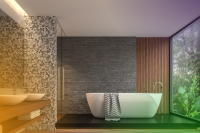Stepping Up Your Small Bathroom: The Best Flooring Options for UK Homes
In the UK, the bathroom is often the smallest room in the house, but its floor takes on huge importance. In a compact space, the flooring choice is critical: it needs to withstand daily moisture and temperature fluctuations, offer safe underfoot grip, and, crucially, use visual trickery to make the room feel bigger and brighter.
For the UK homeowner undertaking a renovation or simply looking to change their bathroom floor, choosing the right material is a blend of practicality, style, and illusion. This comprehensive guide explores the best flooring options for small bathrooms, focusing on durability, water resistance, and techniques to maximise the sense of space.
1. The Practical Imperatives: What Matters Most
Before diving into aesthetics, a small bathroom floor must meet strict performance criteria. Neglecting these could lead to costly repairs down the line, especially in the damp environment of a compact space.
Water Resistance and Durability
The primary concern in any bathroom, especially small ones where water splash is concentrated, is the flooring's ability to resist moisture.
- Impermeability: The material should not absorb water, preventing mould, mildew, and damage to the subfloor (often wooden floorboards in UK homes). Porcelain, vinyl, and sealed stone are top performers.
- Dimensional Stability: The floor must cope with temperature swings (from a hot shower to a cold winter morning) without warping, shrinking, or expanding.
Safety and Comfort
- Slip Resistance: Always look for a floor with a good R-rating (R10 or higher is generally recommended for domestic wet areas) or a textured surface to provide grip, even when wet. This is essential in a small room where quick movements are common.
- Underfloor Heating (UFH): UFH is highly desirable in small UK bathrooms as it removes the need for a bulky radiator, saving wall space. Your flooring must be compatible with UFH—porcelain, stone, and specific types of vinyl are excellent conductors.
Visual Expansion: The Golden Rule
The best flooring for a small room helps the space appear larger. The secret is continuity and minimal distraction. The fewer breaks and visual patterns there are, the more expansive the floor will look.
2. Porcelain and Ceramic Tiles: The Versatile Champion
Porcelain tiles are arguably the gold standard for small UK bathrooms, offering a perfect balance of practicality and visual potential.
Pros for Small Spaces
- Near Impermeability: Porcelain has an extremely low absorption rate (less than 0.5%), making it virtually waterproof and ideal for wet areas, including wet rooms.
- Durability and UFH Compatibility: It is incredibly hard-wearing, scratch-resistant, and an excellent conductor and retainer of heat from underfloor heating.
- Visual Variety: Modern porcelain can flawlessly mimic natural stone, wood, concrete, or bold patterns.
Maximising Space with Porcelain
|
|
|
|
|
|
|
|
|
|
|
|
|
|
|
|
The Rectangular Illusion
If you use long, rectangular tiles (like wood-effect planks), lay them lengthways down the longest dimension of the room. This draws the eye along the room, making a narrow space feel deeper.
3. Luxury Vinyl Tile (LVT) and Sheet Vinyl: The Budget-Friendly Workhorse
LVT and high-quality sheet vinyl (cushion vinyl) are incredibly popular in UK homes, particularly for renovations where budget or subfloor condition is a concern.
Pros for Small Spaces
- 100% Waterproof: LVT and sheet vinyl are non-porous and completely waterproof, making them ideal for high-splash areas and upstairs bathrooms where leaks are a major concern.
- Warmth and Softness: Unlike cold stone or tile, vinyl is soft underfoot and feels warmer, which is a significant comfort factor in a small space.
- Easy Installation: LVT is often installed via a click-lock system or adhesive, making it quicker and less disruptive than tiling, particularly suitable for DIY-savvy homeowners.
- Seamlessness (Sheet Vinyl): Sheet vinyl can be installed in a single piece (if the bathroom is small enough), eliminating all seams and grout lines, which is the ultimate trick for visual expansion.
Maximising Space with LVT
- Seamless Looks: Choose LVT designs that mimic light, pale wood or stone. Ensure the plank size is proportionate; overly large or complex patterns can overwhelm a tiny floor.
- Light Tones: Stick to light, simple colours. The reflective qualities of vinyl surfaces can also help bounce light around the room.
Considerations
While LVT is durable, its lifespan may be shorter than porcelain or stone, and it can be susceptible to damage from heavy, sharp items being dropped. Ensure you purchase commercial-grade or heavy domestic LVT for maximum durability.
4. Natural Stone: The Luxury Investment
Natural stone (such as granite, marble, or slate) offers an unmatched sense of luxury and quality. However, it requires careful consideration in a small, wet environment.
Pros and Cons
- Beauty and Value: Stone adds instant, tangible value and sophistication to a home.
- UFH Compatibility: Excellent conductor and retainer of heat.
- Requires Sealing: All natural stone is porous and must be sealed periodically (typically every 1-2 years) to maintain its water resistance. Failure to seal will lead to staining and potential mould growth.
Maximising Space with Stone
- Marble/Limestone: These lighter stones are better than dark slate for brightening a room. Choose large slabs or tiles to reduce grout.
- The Power of Texture: If choosing slate, the natural cleft (rough texture) offers fantastic, inherent slip resistance without the need for additional coatings.
- Avoid Overly Veined Patterns: In a small room, too much visual movement from heavily veined marble can be distracting and overwhelming. Opt for subtle, uniform patterns.
5. Microcement and Resin: The Modern, Seamless Finish
For the homeowner seeking a contemporary, minimalist aesthetic, seamless flooring options are the ultimate solution for small spaces.
Pros for Small Spaces
- Zero Seams: Both microcement and specific resin floors offer a completely uninterrupted finish from wall to wall. This visual continuity is unsurpassed in making a small room feel large and expansive.
- Waterproof: Applied by specialists, these materials form a durable, non-porous, waterproof layer, often used in high-end wet room builds.
- Industrial Chic: They provide a stylish, modern look, typically in shades of light grey, white, or beige.
Considerations
- Specialist Application: This is not a DIY job. Microcement requires professional application over a well-prepared substrate.
- Cost: Due to the specialist labour involved, these can be more expensive than mid-range tiling, though the visual impact is worth the investment for some.
6. Colour and Pattern: Using Aesthetics to Expand Space
The choice of colour and pattern is just as important as the material in a small bathroom.
Rule 1: Light is Right
- Reflectivity: Choose the lightest colour available within your chosen material (e.g., white porcelain, pale grey LVT, creamy limestone). Light colours reflect more light, making the room feel brighter and less enclosed.
Rule 2: Avoid Small, Busy Patterns
- No Mosaics (Usually): While beautiful, small mosaic tiles (less than 100x100mm) result in a very high density of grout lines, which visually chops up the floor, making it look much smaller and busier.
- Pattern Placement: If you love patterned tiles (e.g., Victorian-style encaustic tiles or complex geometric patterns), use them sparingly. The best place is often on a single feature wall, keeping the floor simple and light to draw the eye upwards and away from the floor boundaries.
Rule 3: Extend the Flooring
- Continuity into the Wet Area: In a small space, visually separate the shower area only if it is structurally necessary. For maximum expansion, run the floor tile directly into the shower area using the same tile, only differentiating the slope and using a linear drain. This creates one unified floor plane.
7. Subfloor Considerations: The UK Challenge
Many UK homes have suspended wooden floorboards (joists) rather than solid concrete slabs. This poses a challenge for tiling and requires attention before installation.
The Flexibility Problem
Wood is flexible; rigid materials like tile or stone are not. Any slight movement in the floorboards will cause the rigid tiles or grout to crack.
Pre-Installation Checklist
- Strengthen the Joists: Ensure the floorboards and joists are structurally sound.
- Add Plywood Overlay: Screw down a layer of 12mm or 18mm WBP (Weather and Boil Proof) plywood over the existing floorboards. This is crucial for creating a rigid, stable substrate.
- Decoupling Membrane (Highly Recommended): For large-format tiles, installing a thin decoupling membrane (like Schluter-DITRA) between the ply and the tile adhesive allows for minor movement in the wood subfloor without transferring that stress to the tile layer, significantly reducing the risk of cracking.
Conclusion: The Smart Choice for Small Spaces
For the UK homeowner renovating a small bathroom, the flooring choice should prioritize waterproof durability and visual expansion.
- Best Overall: Large Format Porcelain Tiles with a light colour and matching grout offer the perfect combination of resilience, UFH compatibility, and a sleek, uninterrupted look.
- Best Budget/DIY: High-Quality LVT provides warmth, total waterproofness, and easy installation, with excellent aesthetic mimicry of more expensive materials.
- Best Seamless Look: Microcement or Resin delivers a stunning, modern finish with zero seams, making the room feel immediately larger, though requiring specialist installation.
By carefully considering material properties alongside visual tricks—embracing continuity, light colours, and large surfaces—you can ensure your small bathroom floor is a functional and beautiful feature that actively helps your miniature space feel mighty




